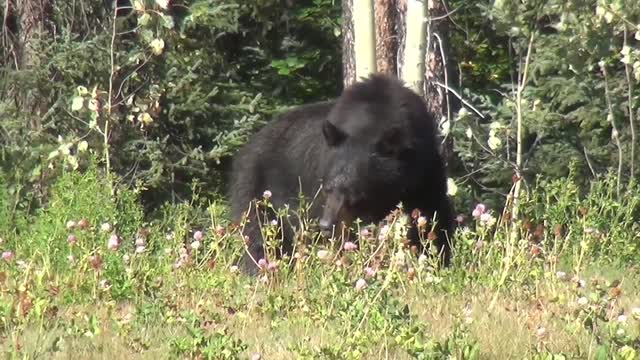Premium Only Content

Black Bear Testing Some Flowers Taste In Forest
The American black bear is the smallest of the three bears species found in North America, and are found only in North America. Black bears have short, non-retractable claws that give them an excellent tree-climbing ability.
Black bear fur is usually a uniform color except for a brown muzzle and light markings that sometimes appear on their chests. Eastern populations are usually black in color while western populations often show brown, cinnamon, and blond coloration in addition to black. Black bears with white-bluish fur are known as Kermode (glacier) bears and these unique color phases are only found in coastal British Columbia, Canada.
American black bears are omnivorous: plants, fruits, nuts, insects, honey, salmon, small mammals and carrion. In northern regions, they eat spawning salmon.
Black bears will also occasionally kill young deer or moose calves.
It is estimated that there are at least 600,000 black bears in North America. In the United States, there are estimated to be over 300,000 individuals. However, the Louisiana black bear (Ursus america nus luteolu) and Florida black bear (Ursus america nus florid anus) are unique subspecies with small populations. The Louisiana black bear is federally listed as a threatened species and the Florida black bear is estimated to number 3,000.
The American black bear is distributed throughout North America, from Canada to Mexico and in at least 40 states in the U.S. They historically occupied nearly all of the forested regions of North America, but in the U.S. they are now restricted to the forested areas less densely occupied by humans. In Canada, black bears still inhabit most of their historic range except for the intensively farmed areas of the central plains. In Mexico, black bears were thought to have inhabited the mountainous regions of the northern states but are now limited to a few remnant populations.
Black bears are extremely adaptable and show a great variation in habitat types, though they are primarily found in forested areas with thick ground vegetation and an abundance of fruits, nuts, and vegetation. In the northern areas, they can be found in the tundra, and they will sometimes forage in fields or meadows.
Black bears tend to be solitary animals, with the exception of mothers and cubs. The bears usually forage alone, but will tolerate each other and forage in groups if there is an abundance of food in one area.
Most black bears hibernate depending on local weather conditions and availability of food during the winter months. In regions where there is a consistent food supply and warmer weather throughout the winter, bears may not hibernate at all or do so for a very brief time. Females give birth and usually remain denned throughout the winter, but males and females without young may leave their dens from time to time during winter months.
-
 0:15
0:15
alizaabc
4 years agoBlack flowers
41 -
 8:10
8:10
B&D Product & Food Review
4 years agoTaste Testing Challenge (Prank)
572 -
 LIVE
LIVE
GamerGril
2 hours agoScariest Game Ever? | SOMA Saturdays
179 watching -
 LIVE
LIVE
sophiesnazz
4 hours ago $0.60 earnedSEASON 4 UPDATE !socials
95 watching -
 1:16:59
1:16:59
T-SPLY
9 hours agoJudge And Protesters Try to Stop ICE Arrest In Court Hallway!
44.3K109 -
 LIVE
LIVE
Odd Man Out
2 hours agoX4 Foundations - Chill, Chat and Current News Discussions
100 watching -
 1:21:36
1:21:36
Michael Franzese
1 day agoSuge Knight Speaks On Diddy, Trump's Pardons, and the Biden's Lies… | LIVE
190K81 -
 LIVE
LIVE
Major League Fishing
1 day agoLIVE MLF BFL All-American Championship!
891 watching -
 LIVE
LIVE
Total Horse Channel
21 hours ago2025 Buckeye Reining Spectacular - Saturday
68 watching -
 3:09:13
3:09:13
Joker Effect
4 hours agoFIRST EVER AMATEUR BOXING EVENT STREAMED ON RUMBLE! BOUGHT TO YOU BY WOLFSDEN BOXING!
38K4